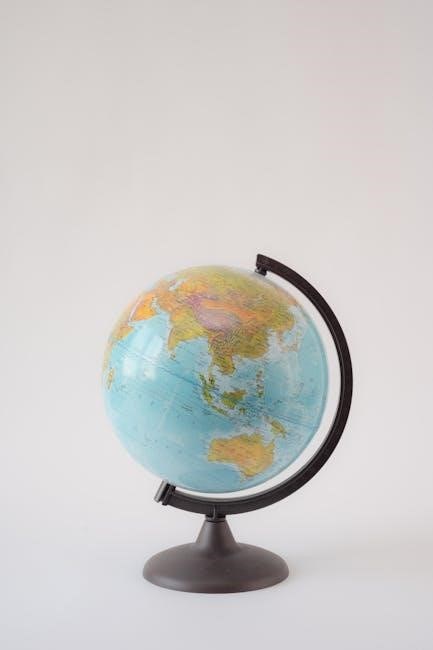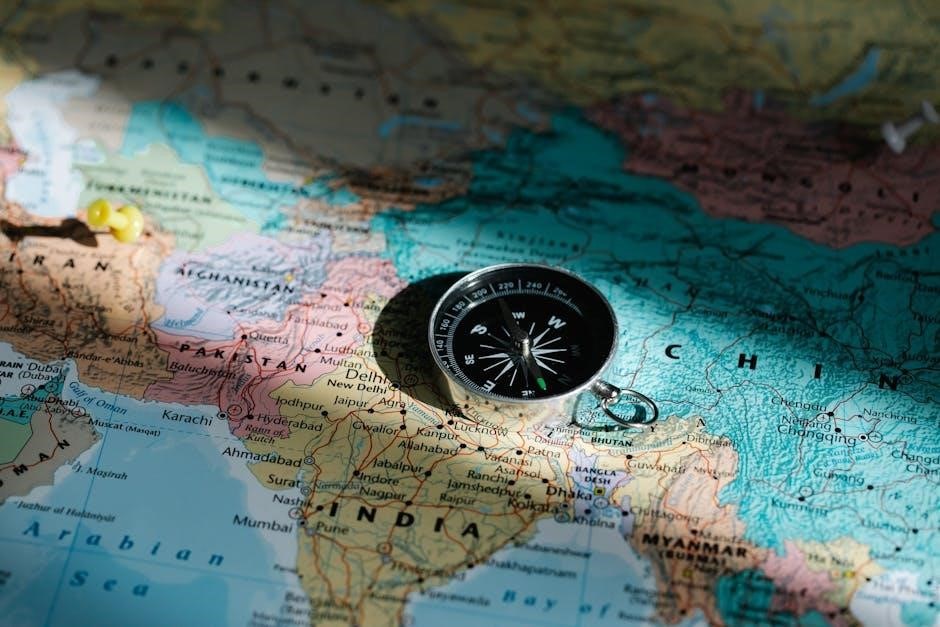Explore the transformative period from 1450 to 1750, focusing on maritime exploration, global trade networks, and the rise of empires. Understand the cultural, economic, and environmental impacts of these developments. Key topics include:
- European motivations for exploration
- American incorporation into Afro-Eurasian networks
- Technological advancements in navigation
- Social and demographic shifts
- Economic systems and global trade dynamics
Utilize study guides, practice exams, and online resources like Quizlet and Crash Course for preparation. Focus on understanding cause-and-effect relationships and comparative analysis for exam success. Mastering these concepts will help you excel in Unit 4.
This unit explores the pivotal period from 1450 to 1750, a time of profound global transformation. It marked the rise of maritime exploration, the establishment of vast empires, and the creation of interconnected trade networks. Europeans, driven by economic and political motivations, ventured across oceans, reshaping the Americas and Afro-Eurasian relations. Key themes include the Columbian Exchange, the impact of exploration on indigenous populations, and the emergence of new economic systems.
During this era, technologies like the astrolabe and caravel enabled navigation across vast distances, facilitating the discovery of new lands. The desire for resources such as gold, silver, and spices fueled these endeavors. Meanwhile, the incorporation of the Americas into global networks led to demographic and environmental changes, including the transfer of crops, diseases, and cultures.
Understanding this period requires analyzing the interconnectedness of global events and their long-term consequences. It sets the stage for later imperial expansions and the modern world order. This introduction provides a foundation for exploring these themes in depth throughout the unit.
Maritime Exploration and Its Drivers
Maritime exploration during 1450 to 1750 was driven by economic, political, and technological factors. European nations sought new trade routes to Asia, spurred by the demand for spices like pepper and cinnamon, which were crucial for both cuisine and medicine. The desire for gold and silver further motivated explorers, as these resources were essential for funding wars and strengthening economies.
The rise of powerful monarchies in Portugal and Spain provided the political will and financial backing for these voyages. Technological advancements, such as the astrolabe, caravel, and sternpost rudder, enabled sailors to navigate the open seas more effectively. The quest for Christian missionary work also played a role, as Europeans aimed to spread their religion to new lands;
These drivers led to the Age of Exploration, with figures like Columbus, Vasco da Gama, and Magellan making historic voyages. Their journeys not only expanded geographical knowledge but also set the stage for colonialism and global trade networks. Understanding these motivations is crucial for grasping the broader impacts of maritime exploration during this period.
Impact of Exploration on the Americas
The exploration of the Americas by European nations had profound and far-reaching consequences. The Columbian Exchange introduced European crops like wheat and livestock to the Americas, while American staples like maize and potatoes transformed diets in Afro-Eurasia. However, the spread of diseases such as smallpox decimated indigenous populations, who lacked immunity to these pathogens.
The arrival of Europeans disrupted existing societies, leading to the collapse of empires like the Aztec and Inca. The exploitation of native labor through systems like the encomienda and the introduction of plantation slavery reshaped the social and economic fabric of the Americas. Cultural exchanges resulted in the blending of European, African, and indigenous traditions, creating new identities.
Religious changes also occurred, as Christianity was imposed on native populations, often replacing or blending with existing beliefs. The long-term environmental and demographic impacts of exploration set the stage for colonialism and the integration of the Americas into global trade networks. These changes fundamentally altered the trajectory of American and world history.
Global Trade Network
The global trade network during 1450–1750 connected Europe, Asia, Africa, and the Americas, driven by maritime exploration. European powers like Portugal, Spain, the Netherlands, England, and France established trade routes, seeking gold, silver, spices, and textiles. The triangular trade system linked Europe, Africa, and the Americas, exchanging goods, enslaved people, and raw materials. Silver from the Americas, particularly Mexico and Peru, fueled global trade, financing European purchases of Asian goods and backing currencies. The Manila Galleons and the Dutch East India Company dominated Asian trade, while the Atlantic system focused on plantation economies. This network facilitated cultural and technological exchanges, such as navigation advancements and crop transfers. The global economy integrated new regions, causing inflation in Europe from silver influx and demographic shifts. The interconnected trade system laid the foundation for modern global economic structures, shaping the world’s political, social, and economic landscapes. Understanding this network is crucial for analyzing the period’s transformations. Key commodities and their flows are central to grasping the dynamics of this era’s global trade.
Rise of Empires
The period from 1450 to 1750 saw the emergence and expansion of powerful empires that shaped global politics, economies, and cultures. European empires such as Spain, Portugal, the Netherlands, England, and France established colonies and trading posts, driven by the desire for wealth, resources, and strategic dominance. The Spanish Empire, for instance, expanded across the Americas, extracting silver and gold, while the Portuguese controlled key trade routes in Asia and Africa. In Asia, the Ming and Qing dynasties in China, the Mughal Empire in India, and the Ottoman Empire in the Middle East maintained vast territories and cultural influence. The rise of these empires was facilitated by advancements in military technology, navigation, and administrative systems. Conquest, diplomacy, and economic exploitation were key strategies used to consolidate power. The growth of empires also led to resistance and rebellion from indigenous populations and rival powers. Understanding the strategies, motivations, and impacts of these empires is essential for analyzing the broader transformations of this era.

Religious and Cultural Exchanges
Religious and cultural exchanges during the period from 1450 to 1750 were deeply influenced by maritime exploration, trade, and the expansion of empires. European explorers and missionaries introduced Christianity to the Americas, Africa, and Asia, while indigenous cultures and religions, such as those of the Americas and Africa, influenced European and Asian societies. The blending of cultures led to syncretic religious practices, such as the fusion of Catholicism with indigenous traditions in Latin America.
Trade networks facilitated the spread of ideas, goods, and cultural practices. For example, Islamic knowledge and art spread into Europe through trade routes, while Asian goods like porcelain and textiles influenced European culture. Missionaries played a key role in spreading religious beliefs, often aligning with imperial ambitions. At the same time, cultural exchanges fostered mutual understanding but also led to conflicts over religious and cultural differences.
- Key examples include the spread of Christianity, Islam, and Buddhism across global networks.
- Cultural blending in art, architecture, and literature.
- The role of missionaries and traders in facilitating exchanges.
These exchanges profoundly shaped identities, beliefs, and practices, leaving a lasting legacy in the modern world.
Social and Demographic Changes
The period from 1450 to 1750 witnessed significant social and demographic changes, largely driven by exploration, colonization, and global trade. The Columbian Exchange led to the transfer of people, plants, and animals between the Americas and Afro-Eurasia, reshaping societies. European colonization in the Americas resulted in the displacement and devastation of indigenous populations due to disease, violence, and forced labor.
Slave trade systems, particularly the transatlantic slave trade, forcibly moved millions of Africans to the Americas, altering demographic landscapes and creating new social hierarchies. Urbanization increased in major trade centers like Lisbon, Amsterdam, and Beijing, as global commerce attracted diverse populations. Social structures were further influenced by the mixing of cultures, leading to the emergence of new identities and communities.
- Impact of the Columbian Exchange on population dynamics;
- Consequences of the transatlantic slave trade on African and American societies.
- Urban growth and cultural diversity in global trade hubs.
These changes reshaped the social fabric of societies worldwide, creating both opportunities and challenges that continues to influence modern demographics.
Environmental and Technological Impacts
The period from 1450 to 1750 saw significant environmental and technological changes that reshaped the world. Technological advancements, such as the development of the astrolabe and the carrack, facilitated maritime exploration and empire expansion. However, these innovations also led to environmental degradation, including deforestation for shipbuilding and the overexploitation of natural resources.

The Columbian Exchange introduced new crops, animals, and diseases, altering ecosystems in the Americas, Africa, and Eurasia. This exchange had devastating effects on indigenous populations and local flora and fauna. Mining, particularly for silver and gold, disrupted landscapes and polluted water sources.
- Technological innovations in navigation and their environmental costs.
- Ecological impacts of the Columbian Exchange.
- Environmental consequences of resource extraction and mining.
These changes underscore the interconnectedness of human activity and the environment during this era, highlighting both progress and its ecological price.
Key Empires and Their Strategies

During the period from 1450 to 1750, several powerful empires emerged and implemented distinct strategies to expand and maintain their dominance. The Portuguese Empire, for example, focused on establishing a robust maritime trade network, leveraging their advanced naval technology and strategic forts along key trade routes to control the flow of valuable commodities like spices and gold.
The Spanish Empire, on the other hand, concentrated on territorial conquest and the exploitation of resources in the Americas. They utilized the encomienda system to manage indigenous labor and extract wealth, while also spreading Christianity through missionary efforts.
- Portuguese maritime dominance and trade monopolies.
- Spanish conquest and resource exploitation.
- Ottoman military and administrative strategies.
Other empires, such as the Ottoman Empire, relied on military prowess and centralized administration to expand their territories. Each empire’s strategy reflected its unique strengths and goals, shaping the global political and economic landscape. Understanding these strategies is crucial for comprehending the dynamics of this transformative era.
Resistance and Rebellion

During the period from 1450 to 1750, resistance and rebellion emerged as significant responses to imperial expansion, economic exploitation, and cultural domination. Indigenous populations in the Americas, Africa, and Asia resisted European colonization through various means, including armed uprisings, diplomatic negotiations, and cultural preservation. For example, the Pueblo Revolt of 1680 in present-day New Mexico was a successful rebellion against Spanish colonial rule, while the Haitian Revolution (1791–1804) became the largest successful slave revolt in modern history, leading to the establishment of Haiti as an independent nation.
- Indigenous resistance: Armed revolts, sabotage, and the preservation of cultural practices.
- African rebellions: Slave uprisings, escapes, and the formation of maroon communities.
- Peasant uprisings: Protests against heavy taxation, labor exploitation, and land expropriation.
These acts of resistance highlighted the resilience of marginalized groups and their efforts to maintain autonomy in the face of imperial and economic pressures. Understanding these movements provides insight into the social and political dynamics of the time, as well as the long-term consequences of colonialism and global trade.
Economic Systems and Global Trade
The period from 1450 to 1750 witnessed the expansion of global trade networks, driven by European maritime exploration and the establishment of colonies. Economic systems evolved to accommodate the exchange of goods, services, and labor across vast distances. Key aspects of this era include:
- The Columbian Exchange: The transfer of plants, animals, and diseases between the Americas and Afro-Eurasia, which reshaped economies and societies.
- Triangular Trade: A system linking Europe, Africa, and the Americas, characterized by the exchange of enslaved people, raw materials, and manufactured goods.
- Merchant Capitalism: European merchants dominated global trade, accumulating wealth through monopolies and exploitation of colonial resources.
- Silver and Gold: The extraction of precious metals in the Americas fueled global trade and economic growth in Europe and Asia;
These economic systems laid the foundation for modern global trade, creating wealth disparities and shaping the political and social structures of empires. Understanding these dynamics is crucial for analyzing the interconnectedness of the world during this period.
Cultural and Religious Transformations
Between 1450 and 1750, cultural and religious transformations reshaped societies globally. The Protestant Reformation in Europe challenged Catholic authority, fostering religious diversity and intellectual movements like the Renaissance; Meanwhile, maritime exploration facilitated cultural exchanges between Europe, Africa, Asia, and the Americas.
- Religious Exchange and Conflict: Missionaries spread Christianity in the Americas and Asia, often clashing with indigenous beliefs. Islam expanded in Africa and Southeast Asia through trade and migration.
- Cultural Blending: The Columbian Exchange introduced new crops, foods, and ideas across oceans, blending traditions and creating syncretic practices.
- Art and Architecture: Global trade influenced art styles, such as Islamic motifs in European textiles and Asian influences in colonial architecture.

These transformations created a more interconnected yet divided world, as cultural and religious identities evolved in response to global interactions. Understanding these shifts is key to grasping the complexities of early modern societies.
Technological Advancements
The period between 1450 and 1750 witnessed significant technological advancements that shaped global exploration, trade, and warfare. These innovations were crucial for maritime exploration and the expansion of empires;
- Maritime Technology: The development of the carrack, caravel, and astrolabe enabled Europeans to navigate the Atlantic and reach new lands. These ships were faster and more maneuverable, facilitating oceanic voyages;
- Navigation Tools: Advances in cartography and the creation of detailed maps improved knowledge of global geography, aiding explorers in their quests.
- Military Technology: The introduction of firearms and cannons revolutionized warfare, giving European powers a strategic advantage over other civilizations.
These technological advancements were not limited to Europe; innovations in agriculture, such as the heavy plow in Europe and new irrigation techniques in Asia, also boosted productivity. Such developments laid the foundation for global interconnectedness and the rise of dominant empires during this era.

Environmental Impacts
The period from 1450 to 1750 saw profound environmental changes due to exploration, trade, and empire-building. These impacts were both local and global in scope.
- Deforestation and Soil Erosion: Increased agriculture and shipbuilding led to widespread deforestation, altering ecosystems and reducing biodiversity.
- Species Transfer: The Columbian Exchange introduced non-native species to new regions, disrupting local flora and fauna.
- Mining and Pollution: The demand for precious metals like gold and silver caused soil erosion and water pollution in mining areas.
- Habitat Destruction: The expansion of empires and trade networks led to the destruction of natural habitats for resource extraction.
These environmental changes had long-term consequences, affecting both human societies and the natural world. Understanding these impacts is crucial for analyzing the broader transformations of this era.
Exam Preparation Tips
To excel in the AP World History Unit 4 exam, focus on targeted preparation strategies. Begin by thoroughly reviewing the course material and practice exams to familiarize yourself with the format and content.
- Master Key Concepts: Ensure a strong understanding of themes like maritime exploration, global trade, and empire-building.
- Practice Writing Skills: Hone your ability to write clear, concise essays and short-answer responses using historical evidence.
- Utilize Online Resources: Leverage study guides, Quizlet flashcards, and video tutorials from platforms like Crash Course and Fiveable.
- Time Management: Practice timing yourself on practice exams to improve speed and accuracy.
- Understand Question Types: Focus on short-answer questions, free-response questions (FRQs), and document-based questions (DBQs).
- Review Feedback: Analyze mistakes from practice exams to refine your approach and strengthen weak areas.
By combining consistent study habits with strategic practice, you can confidently tackle the challenges of the AP World History exam and achieve success.
Additional Resources and Study Materials
Supplement your AP World History Unit 4 study with a variety of resources to enhance understanding and retention. Utilize the official College Board materials, including practice exams and study guides, to gain insights into exam formats and content.
- Textbooks and Guides: The McGraw-Hill 5 Steps to a 5 book and Heimler’s study guides provide comprehensive overviews and targeted strategies.
- Online Platforms: Websites like Fiveable and Quizlet offer interactive flashcards, study groups, and detailed study plans tailored to Unit 4 topics.
- Video Tutorials: Platforms such as Crash Course and Khan Academy feature engaging video lessons that break down complex historical concepts.
- Community Support: Join online forums and study groups to collaborate with peers, share resources, and discuss challenging topics.
- Practice Exams: Regularly take timed practice exams to refine test-taking skills and identify areas for improvement.

These resources, combined with consistent study habits, will help you thoroughly prepare for the exam and master the content of AP World Unit 4.
